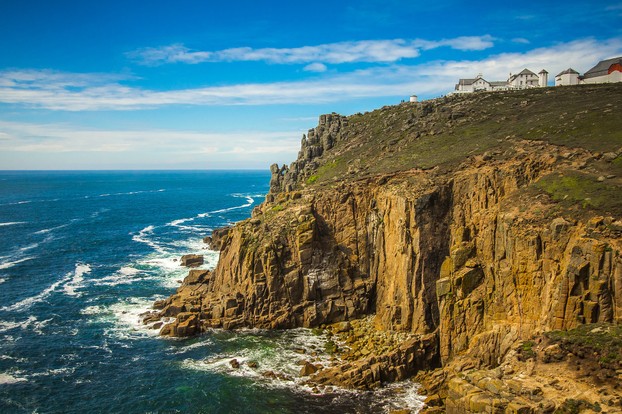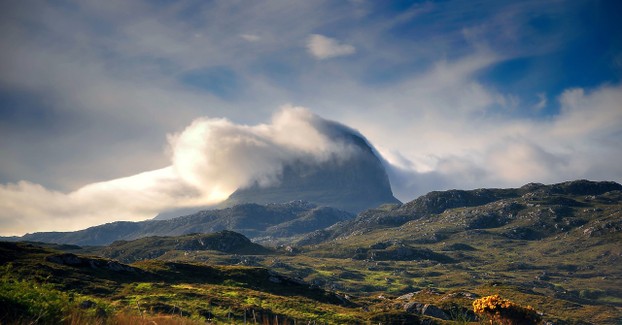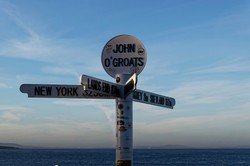Britain is a lengthy isle, and so in Scotland the relative lengths of day and night approach Arctic dimensions, the days in Summer being long and the Winter nights correspondingly lengthy. So it is always better to walk in Scotland in Summer, besides the fact that the Scottish climate can be quite severe in Winter. Distances are also lengthy and in the remote North there can be times when an overnight camp can be required. North Scotland has a bothy system, old cottages left unlocked and stocked with some fuel for for the overnight traveler journeying in lonely places, and at times Merrill stayed in these, for they were drier than his trusty tent.
Besides the long distances, there were sometimes occasions when he made little horizontal progress despite thirty miles of walking, for if you look at the map of North Scotland you can see that he sometimes had to walk round a sea loch, much walking where a bridge would have made the route shorter. You can see that after walking the unpopulated wilderness south of Cape Wrath, Britain's north west extremity, where in Winter storms the seas throw hundred pound boulders at five hundred foot sandstone cliffs, he turned right at Cape Wrath and having got some supplies at Durness had to skirt through trackless land around Loch Erribol, though the next inlet, Loch Tongue has a bridge.
Turning right at Duncansby Head, Britain's northernmost point, he headed down the East Coast of Britain. The East of Britain presents walking very different from the West of Britain, for the West is more rugged and indented, whereas the East is less indented than the rocky West.
Psychologically the East Coast brings its own problems, for the long vistas ahead of you can be daunting for one who has already done many miles and it is tempting to become disillusioned. This is where the mindset comes into play. The marathon walker must be dedicated and single minded, content with their own company, while being capable of responding to those that he/she meets. Staying power, both physical and mental is a must. Being so personally involved in a walk that not finishing it is unthinkable and intolerable is part of this mindset. Merrill seems to have these qualities in abundance.








 Women of the Gospelson 10/11/2025
Women of the Gospelson 10/11/2025
 Religious Gardenson 08/25/2025
Religious Gardenson 08/25/2025
 Doctor of the Church: John Henry Newmanon 08/03/2025
Doctor of the Church: John Henry Newmanon 08/03/2025
 Restoring the Palm Houseon 07/16/2025
Restoring the Palm Houseon 07/16/2025



Comments
There are basic facilities, such as a freezer and showers.
Thank you for your comment below, in answer to my previous observation and question.
A lengthy stay suggests bathing, bedding, drinking, eating.
Would there be freezers, microwaves, ovens, refrigerators, running water, stoves, toasters?
There is no rule. Stay as long as you like
Thank you for your comment below, in answer to my previous observation and question.
Your answer about "an annual subscription and fees to stay in the hut overnight" intrigues me.
Is there a one-night stay only or is it possible to stay two, three, maybe more nights?
You pay an annual subscription and fees to stay in the hut overnight.
The computer crashed before I conveyed the other component of my comment-question below.
Your answer two comment boxes down advises us of huts as "funded by membership fees."
Do climbing clubs do fund-raising for their huts and other membership benefits?
Thank you for your comment below, in answer to my previous observation and question.
Some clubs appreciate their members by avoiding big leaps in charging more for membership fees even as other clubs aver being expensive, for big jumps in charging more for such fees.
Are British Isles-er clubs predominantly among the former, the latter or both?
Huts are funded by membership fees. Grants are not provided
Thank you for your answer below, on Aug. 5, 2017, in answer to my previous observation and question.
British-Isles charities intrigue me in such charitable callings as bothy-maintaining, repairing, replenishing.
What monetary source -- contributions, fundraising, grants? -- makes it all possible?
There is a charity called The Mountain Bothies Association, whose members replenish, repair and maintain bothies.